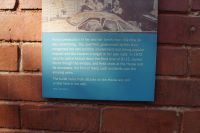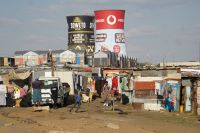There’s gold in them hills
May 19, 2019 Sabi Sabi
We spent yesterday exploring Johannesburg, and, in the process, learning about the history, which, as in many other countries, helps explain the present (and the challenges of doing business there). Johannesburg is a late 19th century city, founded on gold. As I’ve mentioned, that gold helped shape South Africa in more ways than one. The Boers, who had left the Cape Colony partly because the British had abolished slavery, settled two new Boer states—the Orange Free State and the Transvaal.
The discovery of gold brought in an influx of non-Dutch miners. President Paul Kruger engineered legislation taxing the foreigners, but denying them the vote. It was one of the pretexts the British seized upon to pressure the Boers, who declared war and essentially fought the British empire to a standstill; the truce which ended the conflict was the beginning of the Union of South Africa. Thus, what is now South Africa (as opposed to the Cape Colony), started in Johannesburg. It’s now over seven million people, and while only 8 of the 30 or so mines that once gave the world over 2/3 of its gold are still functioning, many barely, the slag piles that resemble yellow mountains around the city can now be mined profitably with new technology—and sometimes yield uranium, platinum, and manganese. Thus, there is gold in them hills, still. The mines, as I mentioned, also fostered the race relationship that eventually hardened into apartheid, the rigid separation of the races. The Union of South Africa in 1910 began the process; middle class Blacks had been able to vote in the Cape Colony, for example. The Union took that vote away from all Black people. As apartheid reached its peak after World War II, the system became law.
We learned about the evolution of apartheid at the Apartheid Museum in Johannesburg. Ironically, the museum has a connection with gold, too. It’s located next to a theme park, Gold City, and a casino, that are on the site of the original gold mine. The concessioners got the right to build the casino in exchange for constructing the museum documenting apartheid. When you enter, you randomly get a ticket identifying you as white (Blankie in Afrikaan) or colored (non-white) and you enter the appropriate gate for the first exhibit, which gives you an idea of what apartheid was like.
Actually, as our guide pointed out, there were five “classes” of races. Northern Europeans were in class 1; in class 2 were southern Europeans (Italians, Greeks, and Spaniards were not quite class 1); class 3 consisted of mostly Asians; and class 5 were Blacks. Class 4 were Blacks who changed their name to a Dutch variant. One such was Hector Peiterson, who was born Pitro, in the black township of Soweto (Southwest Township), once home for mine workers, now a neighborhood of 2.5 million Blacks, with six
whites—four priests and two NGO workers.

 Soweto played prominently in Apartheid Museum. Nelson Mandela and Bishop Tutu, who won Nobel prizes for their work in ending apartheid, lived on the same street in Soweto. Mandela’s house is a tourist spot, complete with bullet holes from several police raids (he spent many years in the Robben Island prison, while his wife and daughters lived in the government-built house in Soweto; they added a brick wall between the kitchen and the living room so they could defend themselves from the random police violence).
Soweto played prominently in Apartheid Museum. Nelson Mandela and Bishop Tutu, who won Nobel prizes for their work in ending apartheid, lived on the same street in Soweto. Mandela’s house is a tourist spot, complete with bullet holes from several police raids (he spent many years in the Robben Island prison, while his wife and daughters lived in the government-built house in Soweto; they added a brick wall between the kitchen and the living room so they could defend themselves from the random police violence).
The Apartheid Museum documented the struggle to end apartheid, which got tangled up in the cold war. South Africa, being against communism, was helped by the United States in its war to keep Namibia and Angola from being taken over by political parties supported by Cuba, China, North Korea, and Russia. In fact, it was the CIA who told the South African government where Mandela was hiding, which led to his arrest and incarceration until 1990.
The Pieterson museum in Soweto focuses on one of the key events in the movement to end apartheid: a student uprising in Soweto. The target was to get a repeal of a white South African demand that all classes be taught in Afrikaans, the quasi-Dutch language of the Boers (and even today the second most spoken language in the country, but mostly by whites). The protest turned ugly, and between 67 (official) and 700 (unofficial) protesters were shot, the first being the twelve-year old Pieterson. It led to
a number of boycotts of South Africa by most other countries, and the isolation of the country internationally. In the effort to become self-sufficient, South Africa created businesses that were not competitive; when the bans were lifted when apartheid ended, it exposed a gap still plaguing the economy. Blacks had essentially been denied all opportunity for upward mobility.
To round out the story, we went through Johannesburg’s Central Business District, the old downtown. Once a prosperous white-dominated area, the city’s core suffered from violence and white flight, with many buildings having only shops of the first floor. We went to the SAB museum in the area, and our guide called the bus to take us the two blocks to AngloGold rather than let us walk it. In a lot of ways, the plight of South Africa is a function of its history. The government has built, we’ve been told, over 3.5
million homes, but needs to build 10 million more to end the shantytowns of containers converted with aluminum roofs. No wonder foreign investors are squeamish and South African bonds are mostly junk rated. That’s the cost of capital again!
There’s gold in them hills, but not all glitters.
Carolyn and I are experiencing the new “gold”…tourism, in one of the private game reserve parks. Our new best friends from the faculty development in business trip have mostly started their way back home. As you might have gathered from my blog, it was an enjoyable group and a great experience, capped last night by African dancers and an oxtail dinner. Now to deal with only animals….
The time during Apartheid and Cold War it is an interesting time – I was not aware that it was the CIA that informed South Africa of Mandela’s whereabouts.
South Africa was shaped from the gold and this helped the conflict in the area. Only 8 out of the 30 mines now are providing 2/3 of gold for the world. The mining now can be done with new technology. Interestingly, the Museum Johannesburg is on the site of the original gold mine. The casino that was built gave you a ticket when you enter based on your race and you go through the appropriate door, that is interesting as to what apartheid was like. There were supposedly 5 classes of race. South Africa created businesses that were not competitors even with the bans being lifted. Basically, according to the blog, the African Americans were denied from moving up economically. The business district and old downtown description sounds like a really interesting site to see.
Interesting:)
How interesting that there were 5 classes of race! The Apartheid Museum sounds amazing, I love a good museum and I’ve been to too many to name. I thought the facts of Mandela were interesting–I never knew the CIA told about where Mandela was, and how chilling about the imagery of his house! I think that preservation of artifacts, such as his house, is super important to history. You don’t really get that full effect with a picture. Another interesting fact was the “gold” factor. One would think its shiny gold that sparkles in the light like in the movies, but as you explained, it can be a metaphor for their history–not glittery, but still gold.